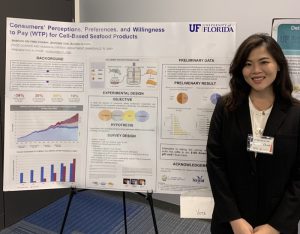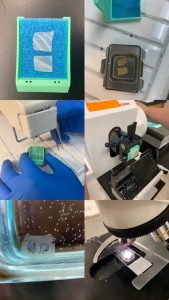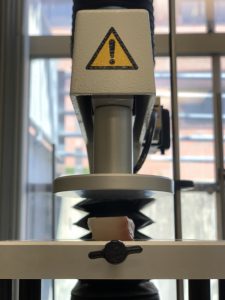 We are so pleased to welcome back Sharon Chuah to our Research Journeys series, which follows the research of graduate students in the Food Science and Human Nutrition program at The University of Florida. Last year, Sharon gave us an inside look at her research into cell-based seafood during the first year of her Ph.D. in food science program. In her first article, Sharon discusses the shortcomings of conventional seafood production to meet the growing global demand for protein. By studying how cell-based seafood can help alleviate these production pressures, she hoped to contribute to research into the benefits of cellular agriculture.
We are so pleased to welcome back Sharon Chuah to our Research Journeys series, which follows the research of graduate students in the Food Science and Human Nutrition program at The University of Florida. Last year, Sharon gave us an inside look at her research into cell-based seafood during the first year of her Ph.D. in food science program. In her first article, Sharon discusses the shortcomings of conventional seafood production to meet the growing global demand for protein. By studying how cell-based seafood can help alleviate these production pressures, she hoped to contribute to research into the benefits of cellular agriculture.
In this installment, she shares how her research developed over the past year, the changes she made in her project, and her top tips for navigating the beginning of pursuing a graduate degree.
When we last heard from you, you were exploring the potential of cellular agriculture to meet the growing demand for seafood. What did you discover over the past year?

Over the past year, my research primarily focused on consumers’ perceptions and willingness to pay for cell-based seafood. As this field is still emerging, it is crucial to understand consumer acceptance for this product’s success. Our perception and willingness-to-pay studies have shed light on the market position, pricing, demand, and target marketing strategy for cell-based seafood.
We found that consumers are willing to purchase cell-based seafood at a price point comparable to conventional seafood, which is a positive sign for the success of this emerging field. I’m excited to share that we will soon be publishing two peer-reviewed articles on our findings. I highly recommend keeping an eye out for these articles as they will provide in-depth insights into our research and discoveries.
Additionally, we have also explored the opportunities and challenges of repurposing biomedical engineering for cellular agriculture production. By understanding the limitations and exploring potential solutions, we are better equipped to develop the most promising biomanufacturing strategies for cellular agriculture. You can learn more about our findings in this peer-reviewed article.

How has your research project changed from your first semester? Why did it change?
Initially, I was exploring different potential projects in the field of cellular agriculture, including fish cell line development and 3D printing strategies. However, as a big food lover, I found myself passionate about recreating the texture of conventional meat/seafood in cell-based seafood. Therefore, I shifted my focus to understanding fish muscle structures to help guide my development into 3D printing strategies. As sensory attributes play a significant role in consumers’ purchasing decisions, mimicking the texture of conventional meat/seafood is critical in cellular agriculture.
What are the next steps with your research?
Our next steps involve characterizing fish muscles, which will serve as the foundation for developing 3D printing strategies for cell-based seafood. By studying the structure-property relationships in different types of fish muscles, we can create a foundational framework for 3D printing fish cells to recreate texture in cell-based seafood.
Furthermore, we will investigate fish cells’ growth characteristics on plant-based scaffolding materials. This will help us achieve our final goal of 3D printing fish cells to recreate the structure of fish in cell-based seafood.

How do you relax and recharge while working on your research project?
To recharge while working on my research project, I have adopted a cat named Phoebe, who has been great for my mental health. Spending quality time with her has been very therapeutic. I also enjoy doing high-intensity Pilates with friends at APEX, which has helped me stay physically and spiritually fit.
What are the top three things you wish you had known going into your graduate program?
Since I have a master’s degree, I knew some of what to expect going into the Ph.D. program. I started a new program in a new city, and I’m glad that I got out of my comfort zone to meet other graduate students and learn more about their experiences in this program. I would say the best advice is to not be afraid to ask graduate students who have already graduated or are deep in the Ph.D. process for advice and guidance. People are always more than willing to help when we reach out, and that is why I started the Food Science and Technology Graduate Student Association (FST-GSA) to serve as a hub that helps other graduate students as well.
Another thing I wish I had known is the importance of networking and collaborating with colleagues and peers early in the program. Lastly, I wish I had known to prioritize self-care and finding ways to relax and recharge amidst the demands of graduate school.

Is there anything else you would like to add about your experience in the UF/FSHN graduate program?
The UF/FSHN graduate program is an excellent program with ample resources and is always supportive of helping graduate students succeed. The program’s quality and the graduate students are top-notch, as everyone is passionate about their research on top of extracurricular activities. For example, I am grateful to have received immense support from the department to be part of the Evil Cakes Product Development Team that represented UF and won first place in the American Society of Baking (ASB) product development competition. Being part of this environment has helped me grow tremendously, especially by challenging myself in different ways.

Looking for more posts exploring graduate research projects in the Food Science and Human Nutrition Department at the University of Florida?
Revisit Sharon’s first year in the food science Ph.D. program here. She is pursuing her degree under the mentorship of Dr. Razieh Farzad.
Dive into the Research Journeys of other graduate students below.
M.S. Food Science
M.S. Nutritional Sciences
Ph.D. Food Science
Ph.D. Nutritional Sciences
 4
4
